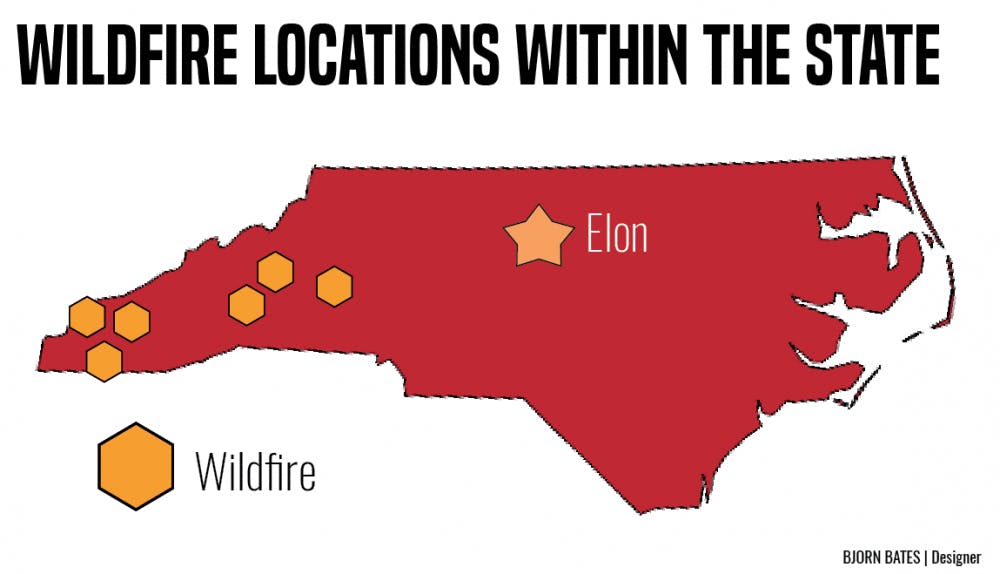Since late October, North Carolina firefighters have been battling wildfires spreading throughout the western part of the state, especially in the drier counties like Watauga.
The first of these devastating fires, the Tellico Fire, began Oct. 23 in Swain County and destroyed more than 14,000 acres of land.
Authorities said 2,500 firefighters and other personnel have been deployed in an attempt to contain several of the largest wildfires in Rutherford, Buncombe, Watauga, McDowell and Macon counties.
The Elon Fire Department sent firefighters to help in the efforts to quench the flames. Fire Chief Alva Sizemore was deployed to Rutherford county from Nov. 14 to Nov. 17 to help quell the Party Rock fire.
“I’ve been in the fire service for over 40 years now, and we have had bad fires in the past but nothing to this magnitude,” said Sizemore. “Nothing in the last 40 years can compare to the amount of acreage that has been burned up. We were put in 12 hour shifts, so that there would be firemen on duty all day fighting the fire.”
According to a press release sent out by the Forest Service on Nov. 27, 85 percent of the Party Rock fire is now under containment.
The National Weather Service is expecting rain this week in the drought-stricken areas of western North Carolina. Authorities are hoping that this rain will help in the fight to contain the raging fires.
“Our second deployment back to the western part of NC was actually called off because the upcoming rain should pretty much bring most of the fires under control,” said Sizemore.
As well as hoping for the rain, common fire stopping tactics such as trench digging, fire control lines and the use of water bombers are currently being used.
Amanda McMahon, an Elon University sophomore living in Candler, North Carolina said, “there was a huge presence of smoke during my entire time being home over Thanksgiving.”
One of the most concerning issues are these fires effects on the air quality in North Carolina.
“I was out to dinner with my friend and before we went into the restaurant it was cold and the air was pretty breathable and then once we came out of the restaurant after dinner there was smoke everywhere and it was really difficult to breathe and it was significantly warmer,” said McMahon.
Freshman Trevor Murrah, a resident of Buncombe County, who took the three hour drive home for Thanksgiving break noticed how throughout his stay in Buncombe his car would be continually showered by bits of bark and ash.
“At first I didn’t realize what is was, I had no idea what those bits were until I realized that it was debris from the wildfires going on in the other counties,” said Murrah.
With thousands of acres of land destroyed in these wildfires, North Carolina Gov. Pat McCrory stated on Nov. 24 that the wildfires have caused over $12 million dollars worth of damage statewide. But the immediate costs of these fires are not the main concern for some.
McMahon said she is primarily concerned for the wildlife in the area: "Our trees and plants and all the animals who inhabit the forests in my area because that is part of what makes Asheville and western North Carolina a natural beauty."
"It also is a huge part of the tourism in that area and it would effect the state not only environmentally but also economically.”
As of Saturday morning, five of the 11 ongoing wildfires listed in the Joint Information Center have been at least 50 percent contained by firefighting forces.
With these fires still not completely out and the holidays coming up, Fire Chief Sizemore asks that the public does its part to keep their communities safe.
“With the holidays coming up, everyone just needs to continue practicing good fire safety, especially with all of the lights, candles and cooking that goes on this time of year. So with all of the festivities coming just use good common sense and stay safe,” said Sizemore.


